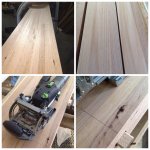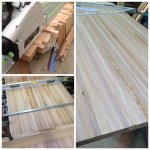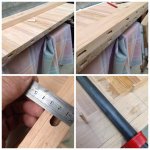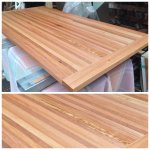Stephen B
Member
- Joined
- May 6, 2013
- Messages
- 2,749
The Butcher Block CounterTop 1650 X 800
Part 1.
As an owner builder of our country house, during the past four years I have constructed panel steps and stringers for a staircase, and three countertop panels.
More recently, I have been conducting repairs and some renovations to our city house. We decided to remove a marble top and replace it with a butcher block countertop made from recycled Australian Mountain Ash.
http://festoolownersgroup.com/member-projects/recycled-australian-mountain-ash/msg260243/#msg260243
My previous experience, examples of my father and two grandfathers furniture and some research had taught me that wood movement and panel cupping could be minimised if a panel was made in sub sections and if end grain alternated. Each subsection was re jointed and all thicknessed prior to final glue up.
http://festoolownersgroup.com/festool-tools-accessories/will-buying-a-domino-help-with-glue-ups/msg262590/#msg262590
However this was to be my first butcher block panel and also my largest panel so far. Having just purchased a Domino 500, I decided to join each subsection with dominos, rather than using my 1400 router with a biscuit cutter.
As can be seen from the photographs all went very well. There was minimal sanding required to even the surface and I felt great self satisfaction with the result.
However with two houses on the go, other projects intervened and the panel was ignored for most of June.
Part 1.
As an owner builder of our country house, during the past four years I have constructed panel steps and stringers for a staircase, and three countertop panels.
More recently, I have been conducting repairs and some renovations to our city house. We decided to remove a marble top and replace it with a butcher block countertop made from recycled Australian Mountain Ash.
http://festoolownersgroup.com/member-projects/recycled-australian-mountain-ash/msg260243/#msg260243
My previous experience, examples of my father and two grandfathers furniture and some research had taught me that wood movement and panel cupping could be minimised if a panel was made in sub sections and if end grain alternated. Each subsection was re jointed and all thicknessed prior to final glue up.
http://festoolownersgroup.com/festool-tools-accessories/will-buying-a-domino-help-with-glue-ups/msg262590/#msg262590
However this was to be my first butcher block panel and also my largest panel so far. Having just purchased a Domino 500, I decided to join each subsection with dominos, rather than using my 1400 router with a biscuit cutter.
As can be seen from the photographs all went very well. There was minimal sanding required to even the surface and I felt great self satisfaction with the result.
However with two houses on the go, other projects intervened and the panel was ignored for most of June.







